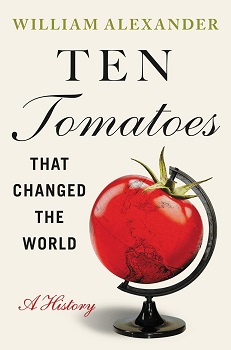Ten Tomatoes That Changed the World: A History by William Alexander
According to the Global Alliance for Improved Nutrition, tomatoes are “the world’s most popular vegetable.” Never mind that tomatoes, which come from the flowering part of the plant and have seeds, are more accurately a fruit — they represent 17% of all vegetables produced annually.
Americans, on average, eat the equivalent of 12 medium-sized tomatoes in a week. Even if you can’t imagine personally munching on that many whole tomatoes, consider that Americans consume roughly 71 pounds of ketchup and 46 pizza slices a year. And then there’s tomato soup, marinara sauce, salsa, tikka masala … in other words, tomatoes are everywhere.
Bainbridge Island author William Alexander is obsessed with tomatoes. His first book, “The $64 Tomato: How One Man Nearly Lost His Sanity, Spent a Fortune, and Endured an Existential Crisis in the Quest for the Perfect Garden,” chronicled his (mis)adventures trying to grow his favorite Brandywine tomatoes. His latest, “Ten Tomatoes That Changed the World: A History,” tells the story of tomatoes’ origins in the New World, and their slow but eventual rise to ubiquity in our culinary and cultural landscape.
Fans of microhistories (think “Cod,” or “Salt,” or “Stiff: the Curious Lives of Human Cadavers”) know what to expect — a pithy, in-depth analysis of every aspect of tomatoes, with cocktail-party-worthy tidbits and fascinating details aplenty.
Alexander starts with the pomodoro, introduced to Italian high society in 1548 by Cosimo de’ Medici. Although this was the first recorded instance of tomatoes in Italy, it took several hundred more years before Italians fully adopted tomatoes as a culinary staple.
Pizza — a dish so common that you can google “pizza + (almost any city in the world)” and find a takeout place — only transitioned into its current form with tomatoes and mozzarella cheese around the 1850s. Italian immigrants brought pizza to New York by the 1890s, but it didn’t take off until World War II. A 1948 article in the New York Times described pizza to the uninitiated: “a round of dough is baked with tomatoes and anchovies and cheese atop, cut into wedges, then eaten with the fingers.”
Foodies — and anyone who’s watched an episode of “Searching for Italy” with Stanley Tucci — have heard about the renowned San Marzano tomato. It’s prized for its firm flesh, easily removed skin, narrow profile (excellent for canning) and sweet taste. Alexander lets readers in on a little-known fact: 95% of the canned tomatoes marketed in the U.S. as San Marzanos are fakes.
Don’t be fooled by the special labels and cans marked “DOP” for “Denominazione di Origine Protetta,” a protected status that is supposed to convey authenticity. In 2010, more than 1,000 tons of counterfeit canned tomatoes were intercepted by Italian police — and this is a drop in the bucket (of tomatoes). As Alexander cheerfully notes, “A thousand tons of fake Marzanos is small tomatoes.”
Ketchup, spaghetti sauce, home gardens, heirloom tomatoes and mass-produced greenhouse tomatoes all get their due, as Alexander joyfully examines all things tomato-adjacent. “Ten Tomatoes” was a finalist for the Washington State Book Award for General Nonfiction for 2023 and is a worthy, juicy read. But beware: You may find yourself ordering some takeout pizza while you devour the rest of the book.
Christine Perkins is executive director of the Whatcom County Library System, wcls.org.
(Originally published in Cascadia Daily News, May 28, 2024.)

